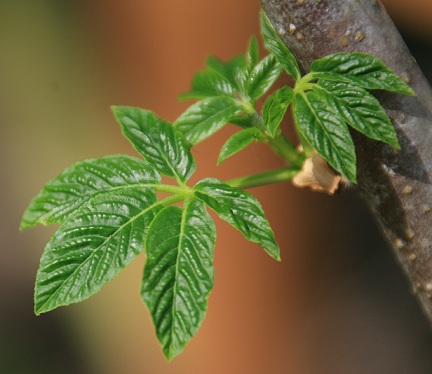|
These Northwest Native trees, shrubs and perennials have been used
historically for household and utilitarian purposes by Native Peoples who
passed their findings on to early settlers.
Take care in identifying plants before using them. Some plants have
almost identical twins which can have harmful effects rather than beneficial
ones!
|

Buckeye
(Aesculus
californica) |
Botanical name
|
Common name
|
Quality
|
Part used
|
Effect
|
|
Aesculus
californica |
Buckeye |
Catch
fish, firewood |
Seeds,
branches and trunk |
Scatter
seeds in streams to stupify fish so they can be picked up. |
|
Alnus
rhombifolia |
White
alder |
Dye,
gunpowder, insect repellant, tanning agent |
Bark,
branches, leaves, cones |
Outer
spring bark makes black dye. Branches used by early settlers to make
gunpowder (inferior, however). Old remedy to remove fleas from
home--pick leaves with morning dew still on them. Lay on floor to
attract fleas. Quickly pick up and destroy as soon as fleas gather.
Bark and cones used as tanning agent. |
|
Aquilegia |
Columbine |
Insect
repellent |
Seeds |
Mash,
moisten and rub vigourously into hair for head lice |
|
Arctostaphylos
uva-ursi |
Kinnikinnik,
Bearberry |
Dye,
tanning agent |
Leaves,
dried |
Ash-coloured
dye. |
|
Ceanothus |
Blueblossom,
Wild lilac, Sweet bush, Buck brush |
Dye |
Roots |
Red
dye |
|
Cercus
occidentalis |
Western
redbud |
Furniture,
construction, weaving material |
Wood,
bark of young shoots |
Mature
wood takes very fine polish. Use bark of young shoots for weaving
material. |
|
Clematis
ligusticifolia |
Virgin's
Bower |
Weaving
material |
Fibers |
Rope,
string bags |
|
Ledum
glandulosum |
Laborador
tea |
Insect
repellent, tanning agent |
Leaves,
branches |
Use
leaves as a wash for lice. Overdose may cause severe headache or
intoxication. Also repels moths. Leaves are used as tanning agent in
Russia. Branches are used in Lapland to discourage mice in
granaries. |
|
Mahonia |
Oregon
grapes |
Dye |
Bark
and roots |
Yellow |
|
Pinus
monticola |
Western
white pine |
Adhesive |
Pitch
from bark |
|
|
Pinus
ponderosa |
Ponderosa
pine |
Adhesive |
Pitch
from bark |
|
|
Ramnus
purshiana |
Cascara,
chittam |
Dye |
Berries,
bark |
Dried
berries make dyes in sap green, bladder green. Green berries make yellow,
good for staining maps or paper. Bark makes yellow. |
|
Rhus
glabra |
Smooth
sumac |
Candles |
Seeds |
Seeds
make candles which burn brightly though smoky, good for outdoors
where they give good light and repel bugs. Berries make black dye.
Leaves gathered after they turn red make yellow dye. Leaves or bark
can be used as tanning agent. Split bark is fine weaving material. |
|
Rosa
gymnocarpa, r. nuttkana, r. pisocarpa, r. woodsii |
Bald-Hip,
Nootka, Pea-Fruit and Wood's Roses |
Air
freshener, society |
Petals,
blooms |
Petals
can be dried and added to potpourri. In olden times, a bloom was
suspended over dining table to signify all conversation was
confidential, giving birth to plaster ornament in center of ceiling
called "the rose." |
|
Umbellularia
californica |
Oregon
myrtle, California bay |
Furniture,
construction, insect repellant, mold preventative |
Wood,
small limbs, leaves |
Mature
wood is beautiful building material, takes a high polish, somewhat
waterproof. Small limbs are used in chicken roosts to prevent lice.
Hang leaves with garlic to prevent mold. |
|
